Expert-Backed Guidelines for Safely Transitioning Your Child from Baby to Regular Laundry Detergent
Many parents worry about when to switch from gentle baby detergent to regular detergent for their toddler’s clothes. As children grow, their skin becomes less sensitive and can handle stronger cleaning products. Pediatricians typically recommend 6 months of age as the appropriate time to make the switch from baby to regular detergent, though some children may be ready earlier or later depending on their individual skin sensitivity.
Understanding when and how to make this transition safely helps protect your child’s delicate skin while ensuring their clothes get properly clean. This comprehensive guide covers everything parents need to know about switching detergents, from timing to product selection to washing techniques.
Table of Contents
Key Takeaways
- Most children can safely transition to regular detergent around 6 months of age
- Children with eczema or sensitive skin may need gentler products longer
- Always test new detergents on a small item before switching completely
- Fragrance-free and dye-free options reduce the risk of skin reactions
- Proper washing techniques matter as much as detergent choice
Understanding when and how to make this transition safely helps protect your child’s delicate skin while ensuring their clothes get properly clean.
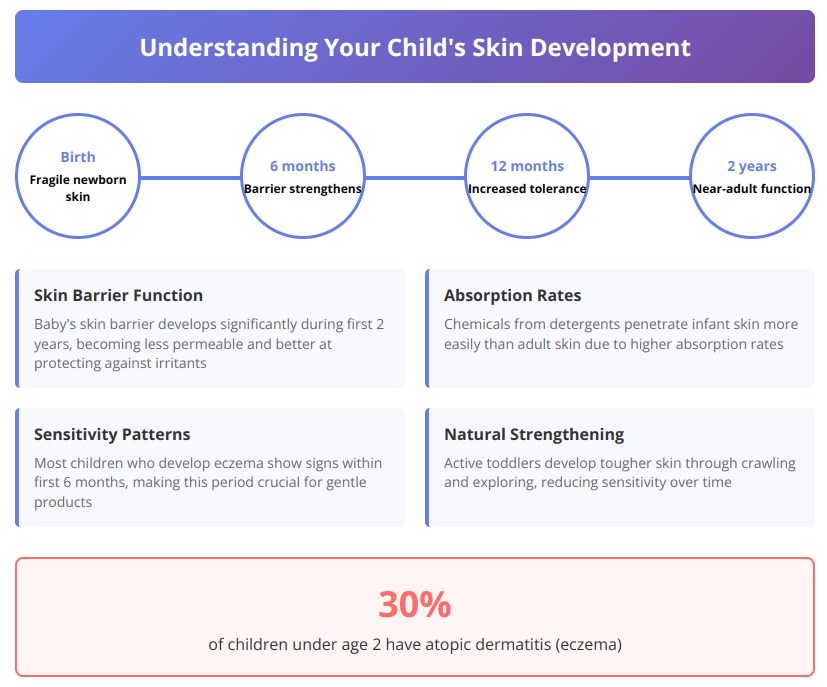
Understanding Your Child’s Skin Development
How Infant Skin Changes Over Time
Newborn skin is remarkably different from adult skin in several important ways. While infant skin is histologically mature at birth, it has unique characteristics that make it more vulnerable to irritation.
The American Academy of Pediatrics provides comprehensive guidelines for cleaning baby clothes that emphasize the importance of gentle care during this vulnerable developmental period.
Skin Barrier Function: A baby’s skin barrier develops significantly during the first two years of life. The outer layer becomes less permeable and better at protecting against environmental irritants. This natural strengthening process is why older toddlers can typically handle stronger cleaning products.
Absorption Rates: Pediatric dermatology research shows that percutaneous absorption of topically applied substances is higher in babies compared to adults. This means chemicals from detergents can penetrate infant skin more easily, potentially causing reactions.
Sensitivity Patterns: According to the National Eczema Association, up to 30% of children under age 2 have atopic dermatitis (eczema). Most children who develop eczema show signs within the first six months of life, making this period particularly important for gentle product selection.
Signs Your Child’s Skin Is Ready
Watch for these indicators that your toddler may be ready for regular detergent:
- Healthy skin appearance: No persistent rashes, dryness, or irritation from current gentle baby clothes
- No family history of severe allergies: Children from families without eczema or contact dermatitis tend to transition more easily
- Active lifestyle: Toddlers who are crawling and exploring often develop tougher skin that’s less prone to reactions
- No reaction to other products: If your child tolerates regular soaps and lotions well, they may handle detergent changes too
When Can You Wash Toddler Clothes in Regular Detergent?
Recommended Age Guidelines
- 6 Months and Older: Board-certified dermatologists, including Dr. Brendan Camp, typically recommend 6 months as the earliest safe transition age. By this point, most babies have moved past the most fragile newborn stage.
- Individual Variation: Some children may be ready earlier, while others need gentler products longer. The key is observing your specific child’s skin response rather than following rigid timelines.
- Special Considerations: Children with eczema, allergies, or other skin conditions may need to delay the transition or use specialized products throughout their early years.
Some children may be ready earlier, while others need gentler products longer.
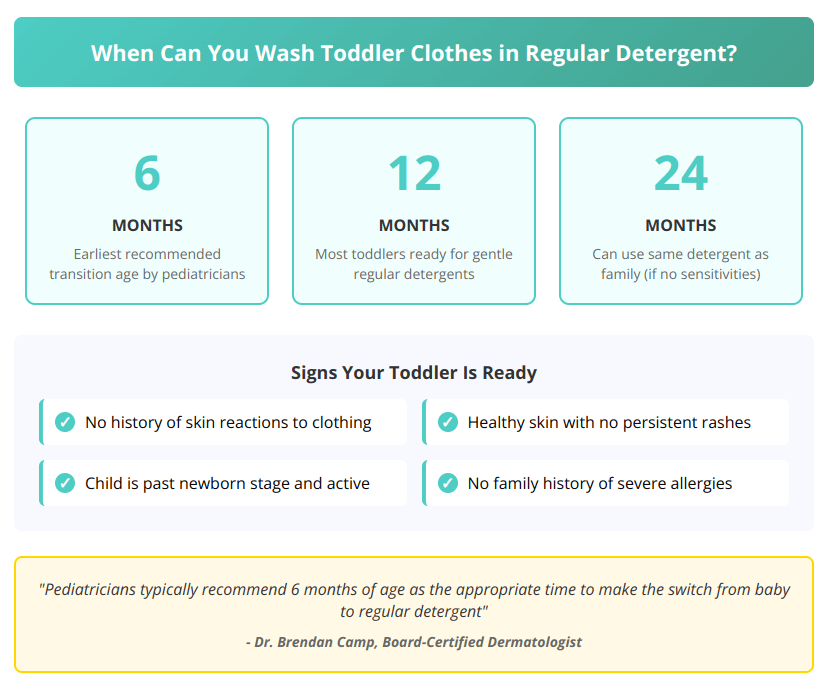
Testing New Detergents Safely
Before switching completely, follow this gradual approach:
- Start Small: Wash one or two items with regular detergent
- Monitor Closely: Watch for any skin reactions over 24-48 hours after your child wears the items
- Check Key Areas: Pay special attention to areas where clothes fit snugly (waistbands, necklines, arm holes)
- Document Results: Keep track of which products work and which cause problems
Can I Wash Toddler Clothes With Regular Detergent?
Yes, most toddlers over 6 months can safely wear clothes washed in regular detergent. However, the type of regular detergent matters significantly.
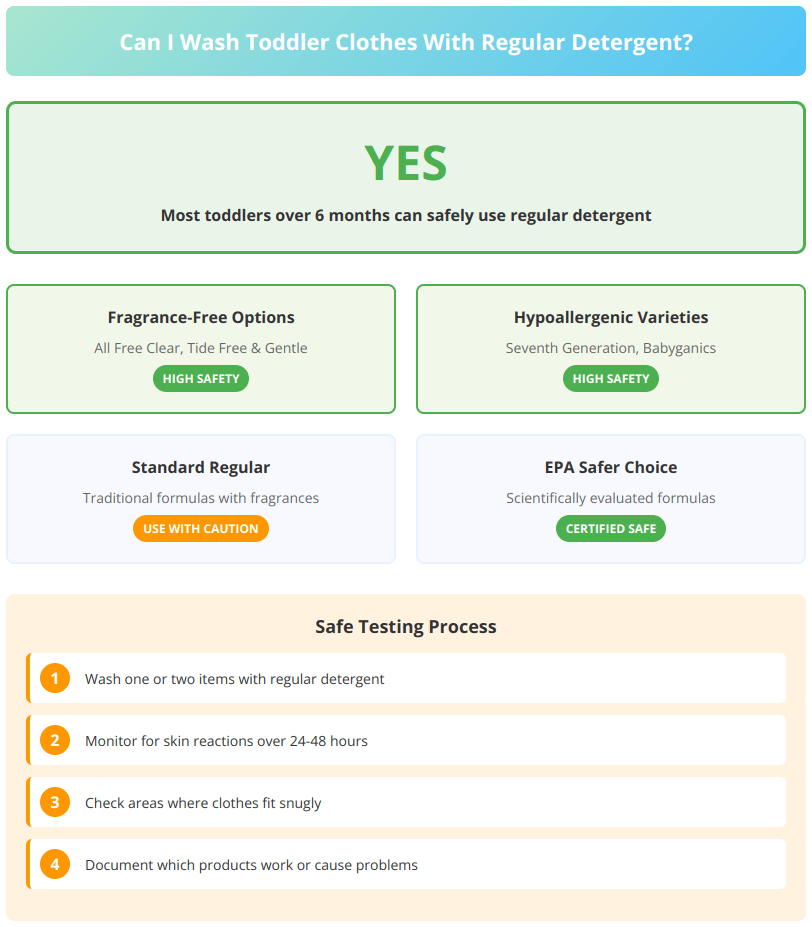
Best Regular Detergent Options
- Fragrance-Free Formulas: Look for detergents specifically labeled “free and clear” or “fragrance-free.” These remove the most common irritants while maintaining cleaning power.
- Hypoallergenic Varieties: Major brands like Tide, All, and Seventh Generation offer hypoallergenic versions of their regular detergents that work well for sensitive skin.
- EPA Safer Choice Certified: Products with this certification have been evaluated for safety by the EPA’s scientific review team, providing extra assurance for families.
Detergent Comparison Chart
| Detergent Type | Best For | Cleaning Power | Skin Safety | Cost |
|---|---|---|---|---|
| Baby Detergent | Newborns-6 months | Moderate | Highest | High |
| Free & Clear Regular | 6+ months, sensitive skin | High | High | Medium |
| Standard Regular | 2+ years, normal skin | Highest | Moderate | Low |
| Eco-Friendly | All ages | Moderate-High | High | High |
What Detergent to Use for a 2 Year Old?
By age 2, most children can handle the same detergent as the rest of the family, with some important considerations.
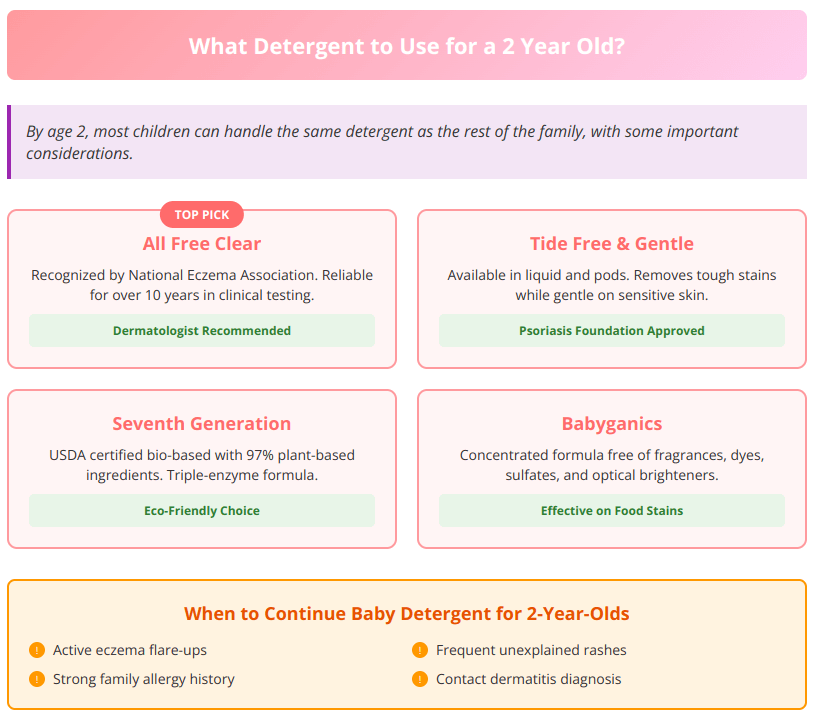
Top Recommended Brands
- All Free Clear: Recognized by the National Eczema Association and recommended by dermatologists nationwide. This detergent has been reliable for over 10 years in clinical testing.
- Tide Free & Gentle: Available in both liquid and pod form, this option removes tough stains while being gentle on sensitive skin. It’s recognized by both the National Psoriasis Foundation and National Eczema Association.
- Seventh Generation Free & Clear: USDA certified bio-based with 97% plant-based ingredients. Uses a triple-enzyme formula for effective stain removal.
- Babyganics Plant-Based: Concentrated formula free of fragrances, dyes, sulfates, and optical brighteners. Particularly effective on food and formula stains.
When to Continue Baby Detergent
Some 2-year-olds may still benefit from specialized baby detergent if they have:
- Active eczema: Flare-ups indicate continued skin sensitivity
- Frequent rashes: Any unexplained skin irritation suggests maintaining gentler products
- Family allergies: Strong family history of contact dermatitis warrants continued caution
How Long Do Babies Need Baby Laundry Detergent?
The duration varies significantly between children, but general guidelines can help parents make informed decisions.
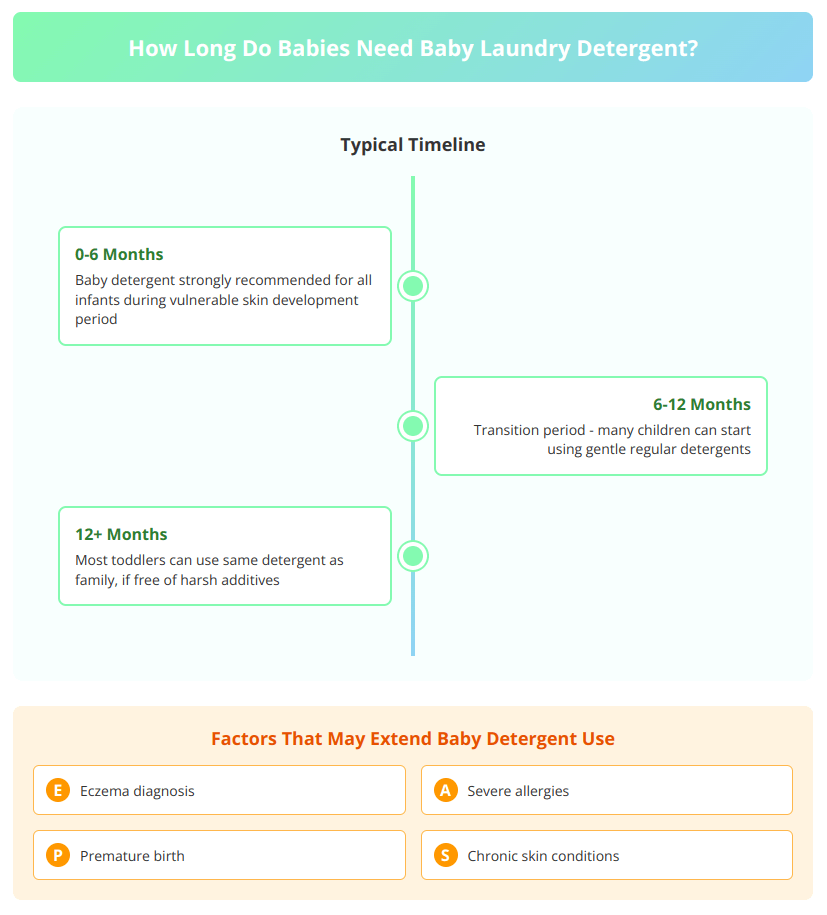
Typical Timeline
- 0-6 Months: Baby detergent strongly recommended for all infants during this vulnerable period when skin barrier function is still developing.
- 6-12 Months: Transition period where many children can start using gentle regular detergents, especially fragrance-free options.
- 12+ Months: Most toddlers can use the same detergent as other family clothes, provided it’s free of harsh additives.
Factors That Extend Baby Detergent Use
- Eczema diagnosis: May require specialized products throughout childhood
- Severe allergies: Multiple food or environmental allergies often correlate with skin sensitivity
- Premature birth: Preemie clothing and care may require extended gentle product use
- Chronic skin conditions: Any ongoing dermatological issues warrant continued caution
Washing Guidelines for Different Ages
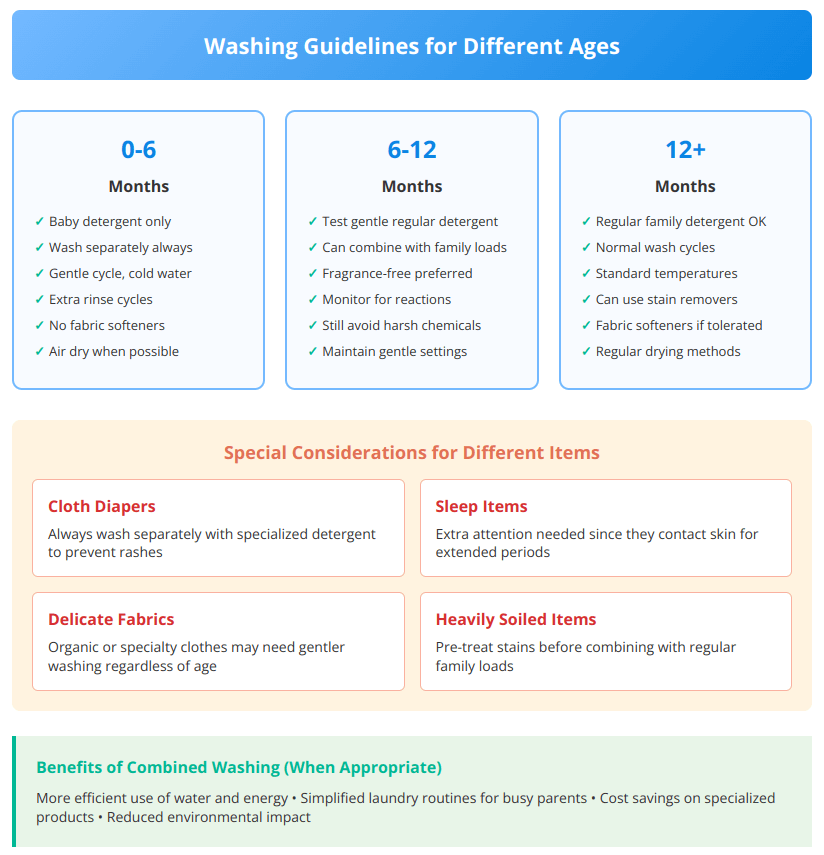
Can You Wash Toddler Clothes With Adult Clothes?
Yes, combining loads is generally safe and practical for most families once children reach 6-12 months of age.
Benefits of Combined Washing:
- More efficient use of water and energy
- Simplified laundry routines for busy parents
- Cost savings on specialized products
When to Wash Separately:
- During transition periods when testing new detergents
- If any family member has active skin reactions
- For heavily soiled items that need pre-treatment
Special Considerations for Different Items
- Cloth Diapers: Always wash separately using specialized cloth diaper detergents to prevent rashes and maintain absorbency.
- Sleep Items: Pajamas and sleep sacks deserve extra attention since they contact skin for extended periods.
- Delicate Fabrics: Organic or specialty baby clothes may need gentler washing regardless of age.
Product Safety and Ingredient Analysis
What Makes Detergent Baby-Safe?
Understanding ingredient safety helps parents make informed choices whether using baby-specific or regular detergents.
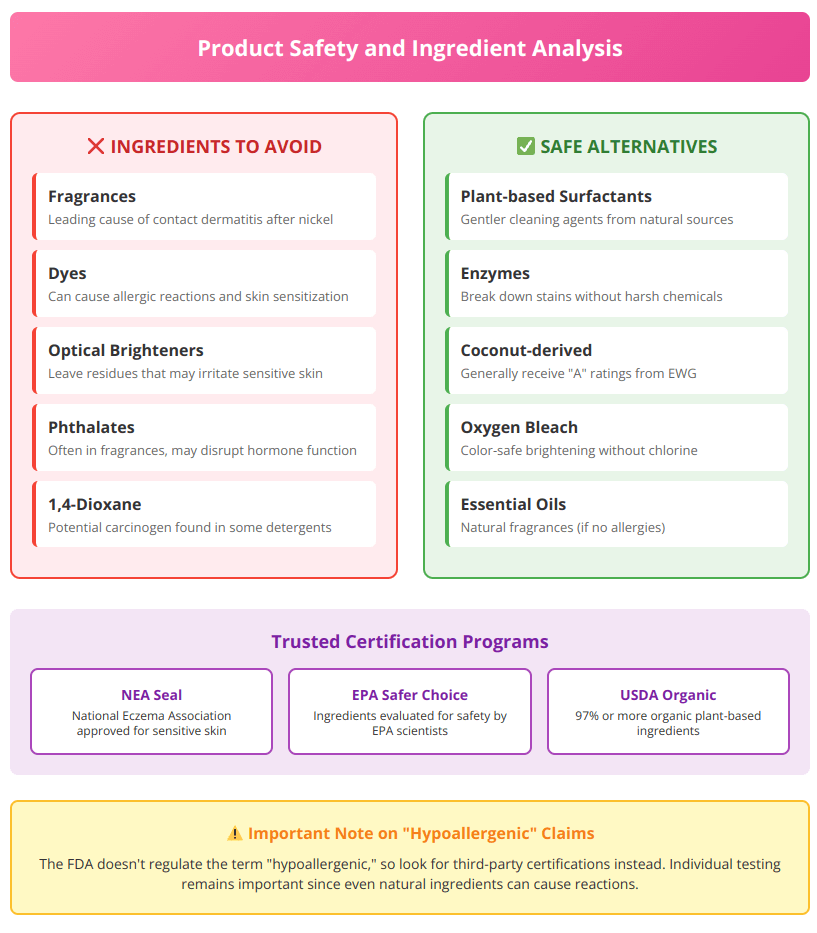
Ingredients to Avoid:
- Fragrances: Leading cause of contact dermatitis after nickel
- Dyes: Can cause allergic reactions and skin sensitization
- Optical brighteners: Leave residues that may irritate sensitive skin
- Harsh surfactants: Can strip natural skin oils and cause dryness
Safe Alternatives:
- Plant-based surfactants: Gentler cleaning agents derived from natural sources
- Enzymes: Break down stains without harsh chemicals
- Coconut-derived ingredients: Generally receive “A” ratings from Environmental Working Group
Understanding Product Labels
“Hypoallergenic” Claims: The FDA doesn’t regulate this term, so look for third-party certifications instead.
“Dermatologist Tested”: While helpful, this doesn’t guarantee safety for all children. Individual testing remains important.
“Free and Clear”: Usually the most reliable indicator of reduced irritant potential.
National Eczema Association Seal of Acceptance
The National Eczema Association maintains a comprehensive product directory of detergents and household products that have earned their Seal of Acceptance. For a product to obtain the Seal, it must meet strict standards established by their Scientific Oversight Committee, including testing for sensitivity, irritation and toxicity, as well as a review of ingredients and formulation data.
Is It Safe to Bleach Baby Clothes?
Bleaching baby and toddler clothes requires careful consideration and proper technique.
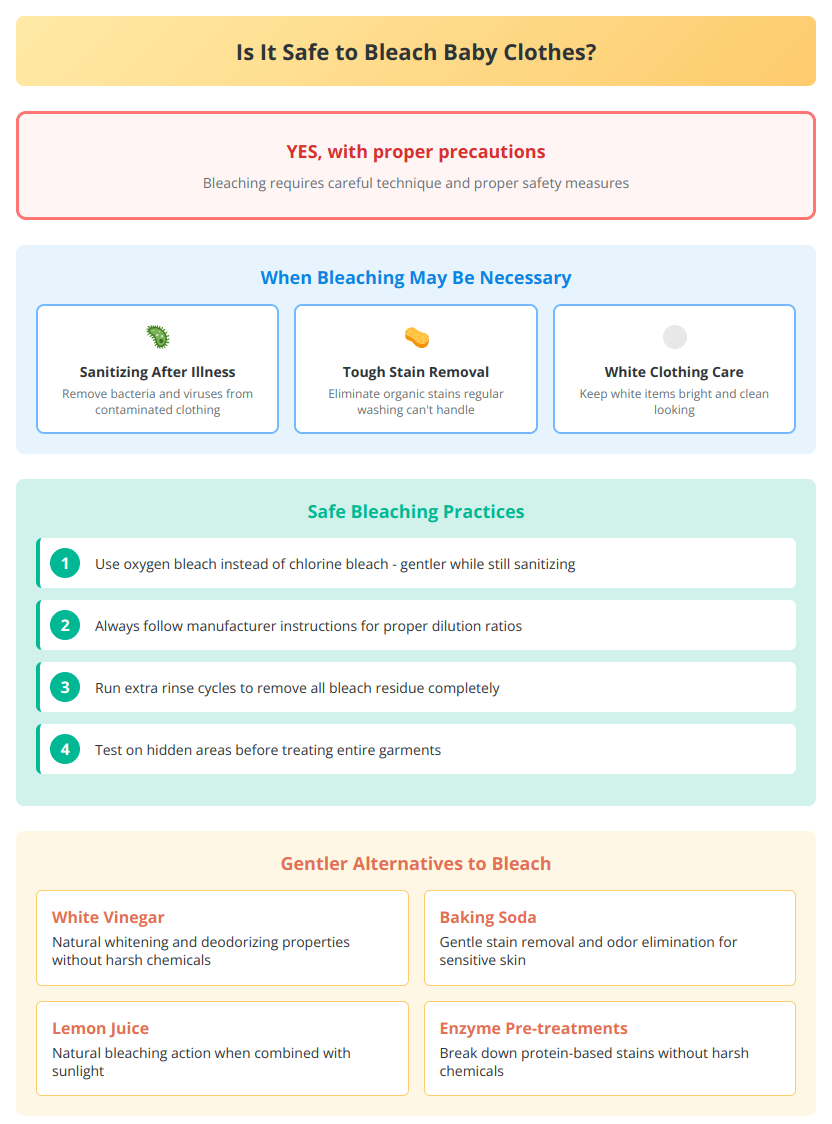
When Bleaching May Be Necessary
- Sanitizing after illness: Removing bacteria and viruses from contaminated clothing
- Stain removal: Eliminating tough organic stains that regular washing can’t handle
- White clothing maintenance: Keeping white items bright and clean
Safe Bleaching Practices
- Use Oxygen Bleach: Color-safe oxygen bleaches are gentler than chlorine bleach while still providing sanitizing benefits.
- Dilute Properly: Always follow manufacturer instructions for dilution ratios.
- Rinse Thoroughly: Run extra rinse cycles to remove all bleach residue.
- Test First: Try bleaching solutions on hidden areas before treating entire garments.
Alternatives to Bleach
- White vinegar: Natural whitening and deodorizing properties
- Baking soda: Gentle stain removal and odor elimination
- Lemon juice: Natural bleaching action when combined with sunlight
- Enzyme pre-treatments: Break down protein-based stains without harsh chemicals
Fabric Considerations and Care
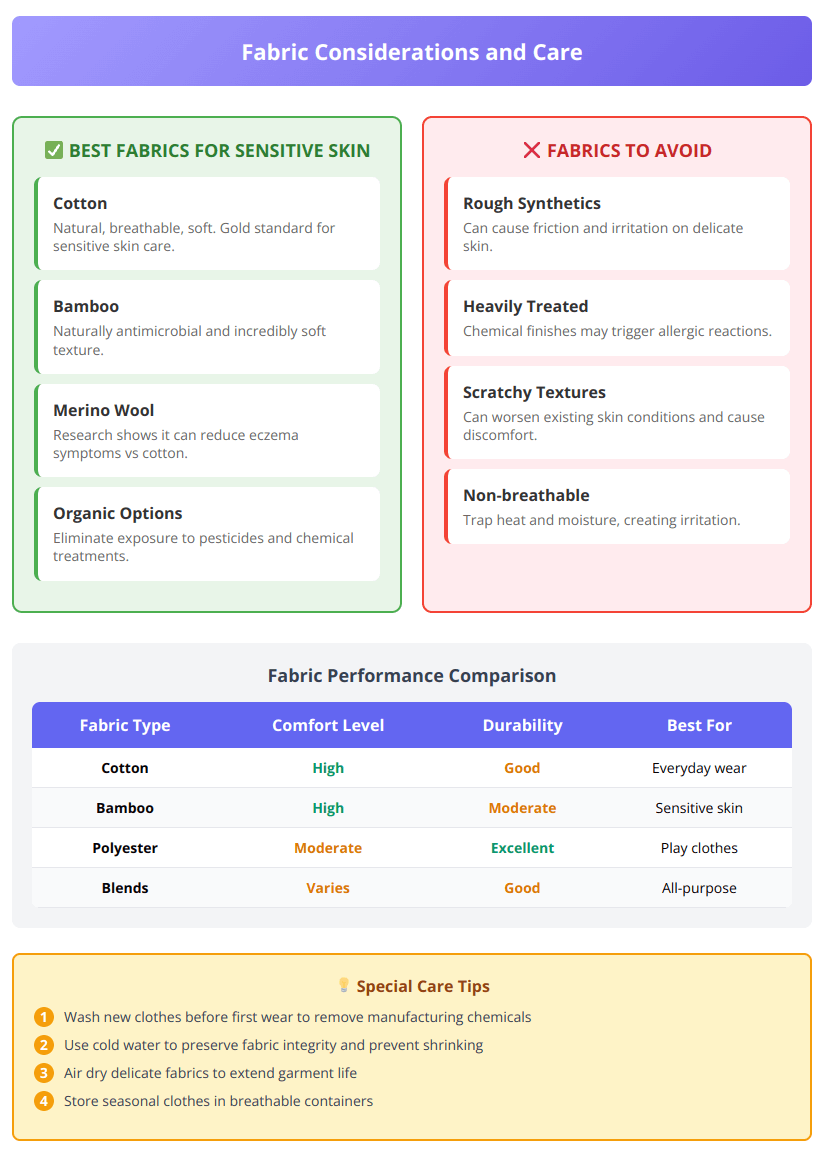
Best Fabrics for Sensitive Skin
- Cotton: Natural cotton fabrics remain the gold standard for sensitive skin due to breathability and softness.
- Bamboo: Naturally antimicrobial and incredibly soft, though it requires careful washing to maintain properties.
- Merino Wool: Research shows superfine merino wool can actually reduce eczema symptoms compared to cotton in some children.
- Organic Options: Organic fabrics eliminate exposure to pesticides and chemical treatments used in conventional textile production.
Fabrics to Avoid
- Synthetic blends with harsh textures: Can cause friction and irritation
- Heavily treated fabrics: Chemical finishes may trigger reactions
- Rough textures: Scratchy materials can worsen existing skin conditions
Advanced Washing Techniques
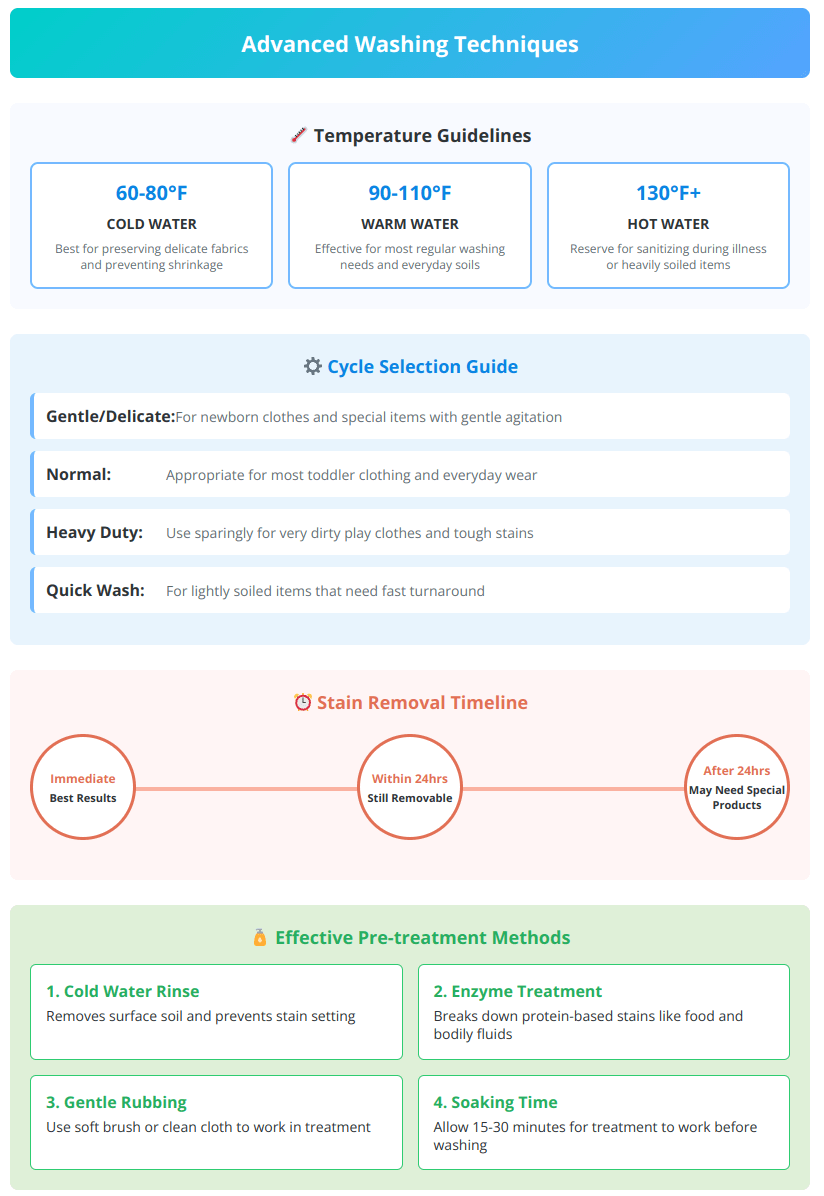
Machine Washing Best Practices
Temperature Guidelines:
- Cold water (60-80°F): Best for preserving delicate baby fabrics and preventing shrinkage
- Warm water (90-110°F): Effective for most regular washing needs
- Hot water (130°F+): Reserve for sanitizing during illness or heavily soiled items
Cycle Selection:
- Gentle/Delicate: For newborn clothes and special items
- Normal: Appropriate for most toddler clothing
- Heavy duty: Use sparingly for very dirty play clothes
Pre-treatment Strategies
Stain Removal Timeline:
- Immediate: Best results when treating stains within 5-10 minutes
- Within 24 hours: Most stains still removable with proper treatment
- After 24 hours: May require specialized products or professional cleaning
Effective Pre-treatment Methods:
- Cold water rinse: Removes surface soil and prevents setting
- Enzyme treatment: Breaks down protein-based stains (food, bodily fluids)
- Gentle rubbing: Use soft brush or clean cloth to work in treatment
- Soaking: Allow 15-30 minutes for treatment to work before washing
When to Stop Washing Baby Clothes Separately
The transition from separate washing to combined family loads depends on several factors beyond just age.
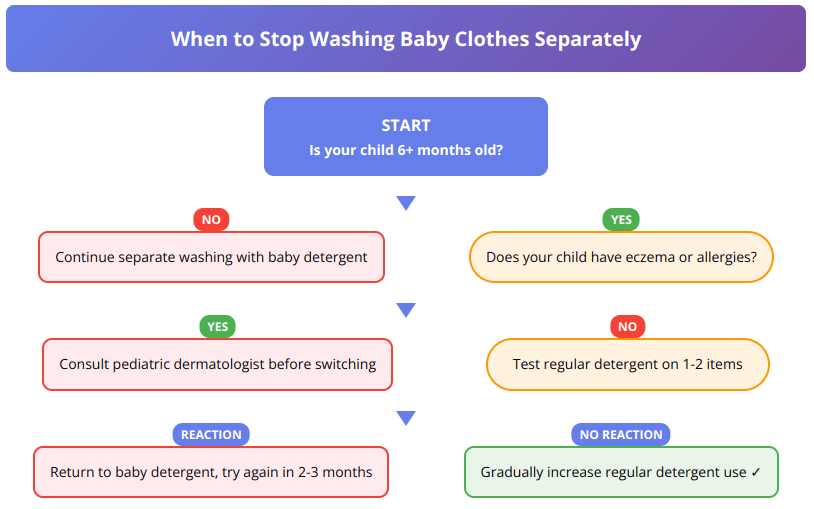
Decision-Making Flowchart
Start: Is your child 6+ months old?
├─ No → Continue separate washing with baby detergent
└─ Yes → Does your child have eczema or allergies?
├─ Yes → Consult pediatric dermatologist
└─ No → Test regular detergent on 1-2 items
├─ Skin reaction? → Return to baby detergent, try again in 2-3 months
└─ No reaction? → Gradually increase regular detergent use
Factors Supporting Combined Washing
- Healthy skin for 2+ months: No unexplained rashes or irritation
- Successful detergent testing: No reactions to regular products
- Family efficiency needs: Large families benefit from simplified routines
- Environmental considerations: Reduced water and energy usage
Signs to Continue Separate Washing
- Any unexplained skin reactions: Better safe than sorry approach
- Recent illness: Immune system changes can temporarily increase sensitivity
- New environmental factors: Moving, new daycare, seasonal changes
- Family history concerns: Strong genetic predisposition to allergies
Product Recommendations by Age and Skin Type

0-6 Months: Ultra-Gentle Options
- Dreft Stage 1: Specifically formulated for newborn skin sensitivity
- Honest Company Baby Detergent: Plant-based with minimal ingredients
- Rockin’ Green Baby Detergent: Enzyme-free formula for most sensitive skin
6-12 Months: Transition Products
- All Free Clear: Widely recommended by pediatricians
- Tide Free & Gentle: Strong cleaning power with reduced irritants
- Seventh Generation Free & Clear: Eco-friendly option with good performance
12+ Months: Regular Family Options
- Arm & Hammer Clean Burst: Effective stain removal, hypoallergenic formula
- Persil ProClean Sensitive Skin: European formula with excellent cleaning power
- Method Free + Clear: Concentrated formula with plant-based ingredients
Environmental and Health Considerations
Chemical Exposure Concerns
Modern parents increasingly worry about chemical exposure in household products.
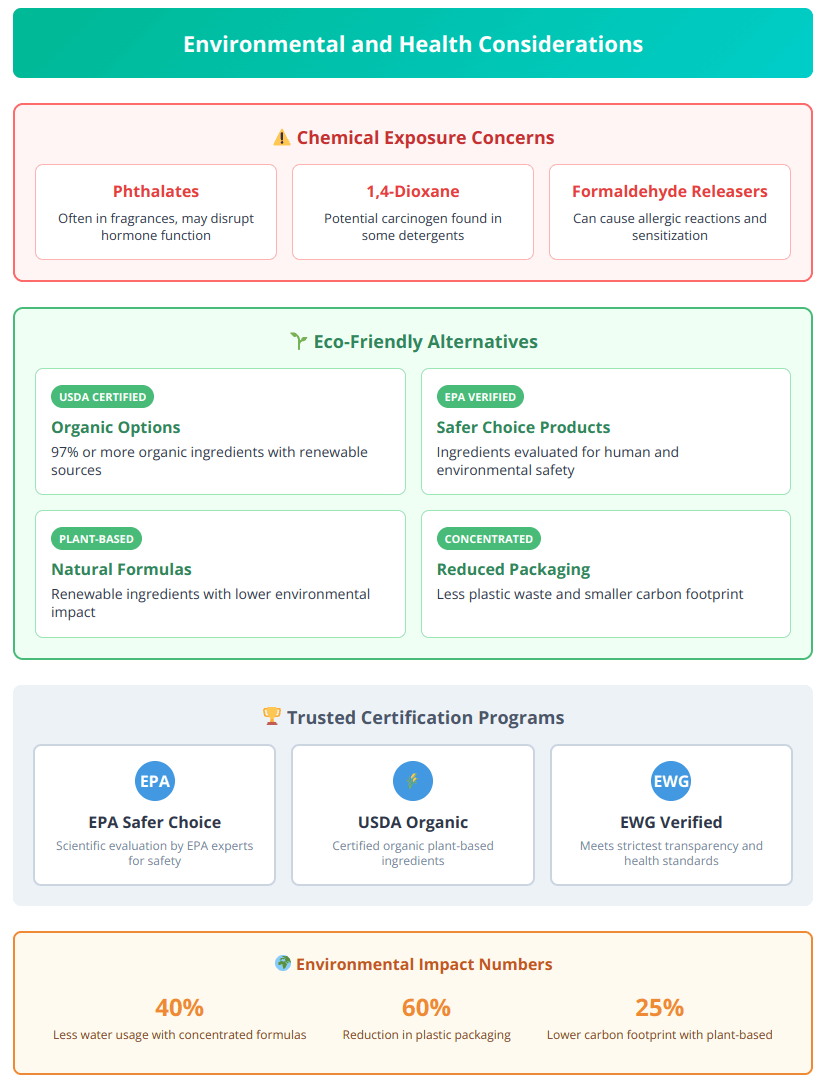
While research continues, some chemicals deserve attention:
- Phthalates: Often found in fragrances, may disrupt hormone function
- 1,4-Dioxane: Potential carcinogen found in some detergents
- Formaldehyde-releasing preservatives: Can cause allergic reactions
The Environmental Working Group offers a comprehensive Guide to Healthy Cleaning that provides safety ratings for thousands of household cleaners, including laundry detergents. Their database helps parents evaluate products based on ingredient safety and potential health concerns, making it easier to choose products with lower chemical exposure risks.
Eco-Friendly Alternatives
- USDA Certified Organic: 97% or more organic ingredients
- EPA Safer Choice: Ingredients evaluated for human and environmental safety
- Plant-based formulas: Renewable ingredients with lower environmental impact
Troubleshooting Common Issues

My Child Developed a Rash After Switching
Immediate Steps:
- Stop using the new detergent immediately
- Wash affected clothing in known-safe detergent
- Document the reaction (photos, timing, affected areas)
- Return to previous safe products
When to See a Doctor:
- Rash spreads or worsens after 24 hours
- Signs of infection (oozing, warmth, red streaking)
- Child shows signs of discomfort or pain
- Fever accompanies skin reactions
The New Detergent Isn’t Cleaning Well
Possible Solutions:
- Increase detergent amount slightly (don’t exceed recommendations)
- Add pre-treatment for stains
- Use warmer water if fabric care allows
- Consider enzyme boosters for protein-based stains
When to Switch Products:
- Consistently poor performance after proper technique adjustments
- Stains set permanently due to inadequate cleaning
- Cost becomes prohibitive due to needing larger amounts
Special Circumstances
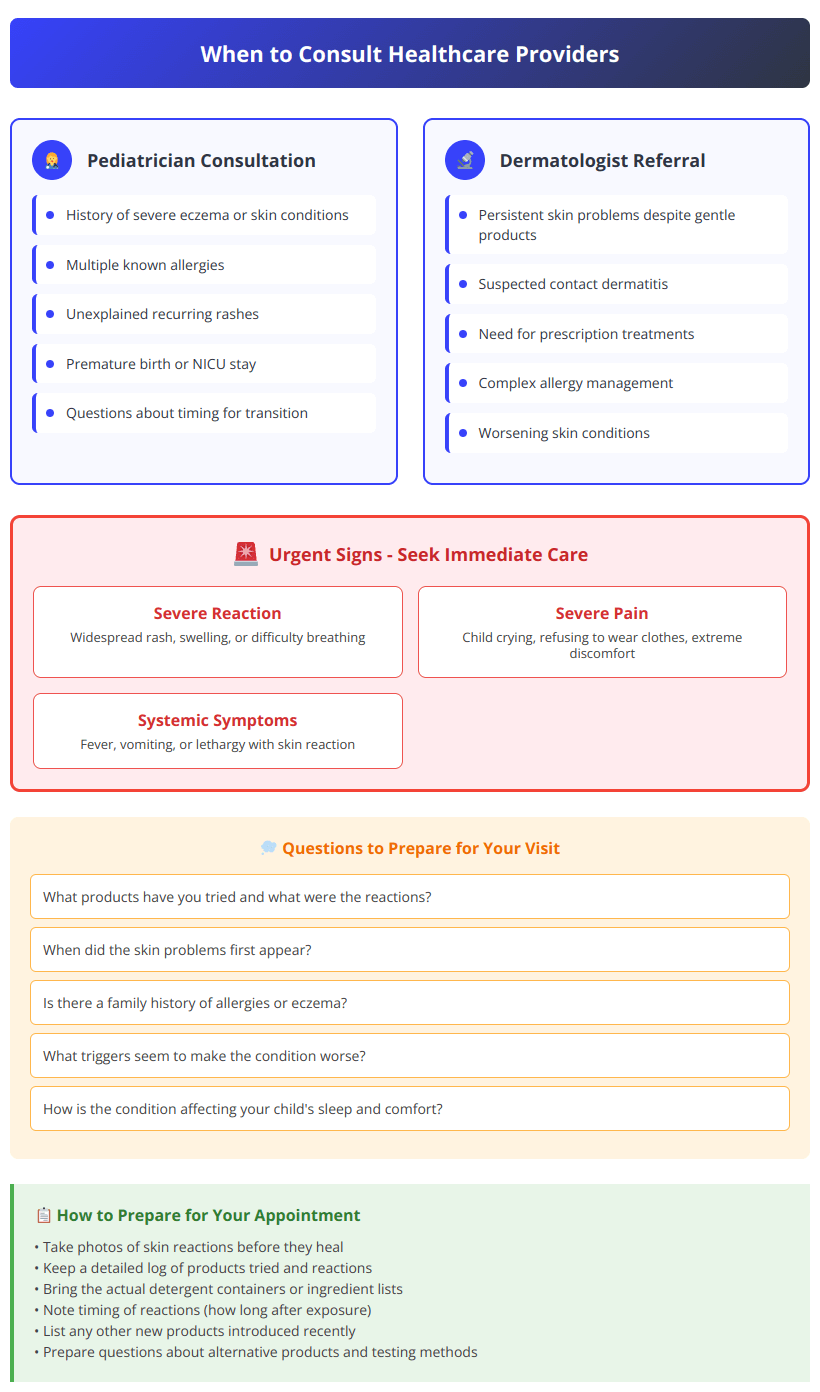
Premature Babies
Premature infants often need extended gentle care due to:
- Delayed skin maturation: Barrier function develops more slowly
- Increased sensitivity: Higher risk of reactions to standard products
- Medical complications: Skin conditions related to NICU treatments
Recommendations: Continue baby-specific detergents until at least 6 months past original due date, or longer based on pediatric guidance.
Children with Chronic Conditions
- Eczema Management: Work with pediatric dermatologists to identify trigger-free products
- Food Allergies: Children with multiple food allergies often have higher rates of contact sensitivity
- Asthma: Fragrance-free products reduce respiratory irritation risk
When to Consult Healthcare Providers
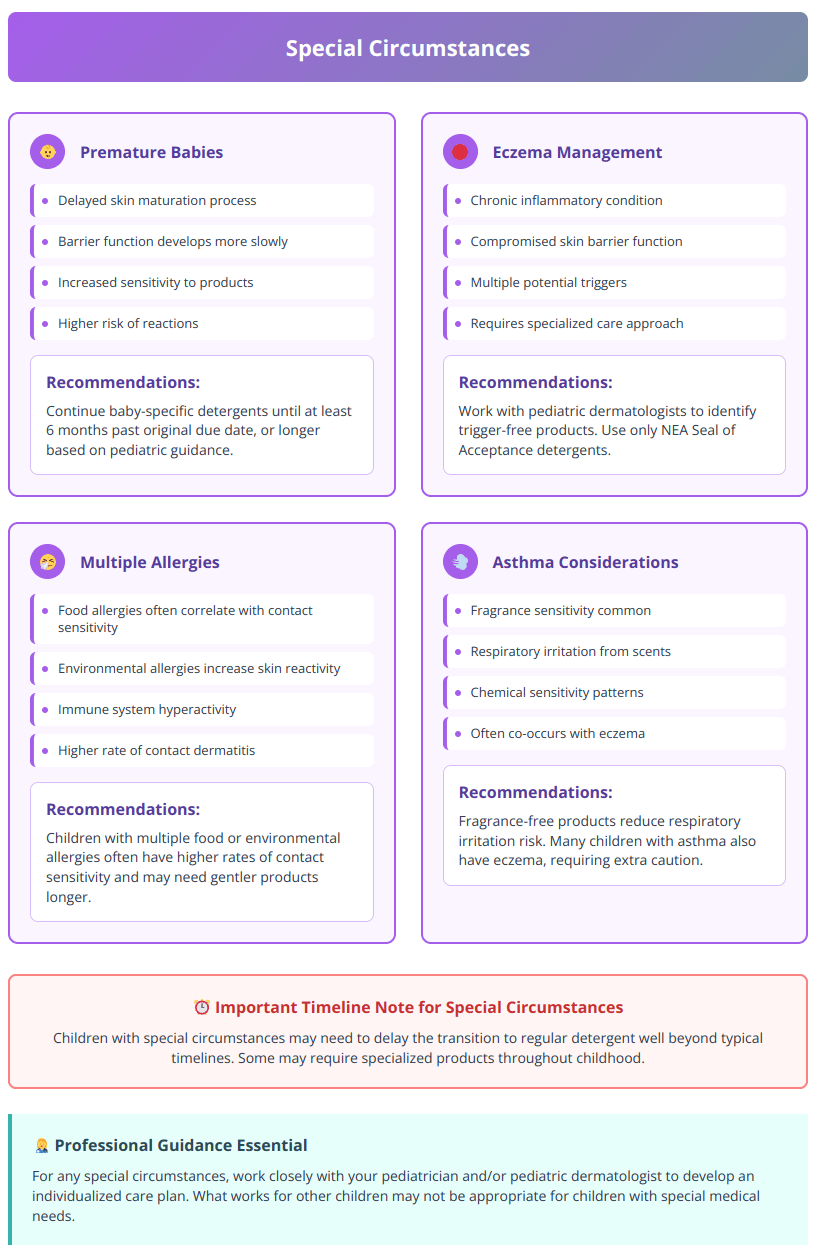
Pediatrician Consultation
Schedule a discussion about detergent choices if your child has:
- History of severe eczema or other skin conditions
- Multiple known allergies
- Unexplained recurring rashes
- Premature birth or NICU stay
Pediatric Dermatologist Referral
Consider specialist consultation for:
- Persistent skin problems despite gentle products
- Suspected contact dermatitis
- Need for prescription treatments
- Complex allergy management
Frequently Asked Questions
Can I Use Ariel to Wash Baby Clothes?
Ariel offers several formulations, including sensitive skin versions that may be appropriate for older toddlers. However, standard Ariel contains fragrances and brighteners that could irritate sensitive skin. If considering Ariel, choose their “Sensitive” or “Free & Clear” variants and test carefully.
Is the Brand All Laundry Detergent Safe for Babies?
All Free Clear is widely recommended by pediatricians and has received recognition from the National Eczema Association. It’s one of the most thoroughly tested gentle detergents available and is generally considered safe for babies over 6 months.
What Is the Difference Between Stage 1 and Stage 2 Baby Detergent?
Stage 1 (Newborn): Ultra-gentle formulas with minimal ingredients, designed for the most sensitive newborn skin (0-3 months)
Stage 2 (Active Baby): Slightly stronger cleaning power while maintaining gentleness, formulated for babies who are more active and create different types of stains (3+ months)
Is Molly Suds Safe for Babies?
Molly’s Suds offers plant-based, fragrance-free options that many parents find suitable for sensitive skin. However, like all products, individual testing is important since even natural ingredients can cause reactions in some children.
Can You Use Fairy Fabric Softener on Baby Clothes?
Fabric softeners, including Fairy, are generally not recommended for baby clothes as they can:
• Leave residues that irritate sensitive skin
• Reduce absorbency of towels and cloth diapers
• Contain fragrances that may trigger reactions
Consider using dryer balls or vinegar rinses as gentler alternatives.
Do I Really Need to Use Baby Laundry Detergent?
For most newborns (0-6 months), baby-specific detergents provide important protection during the most vulnerable skin development period. After 6 months, many children can transition to gentle regular detergents, making baby-specific products optional for most families.
The key is choosing products appropriate for your child’s individual sensitivity level rather than automatically assuming baby-branded products are necessary throughout toddlerhood.
Safety Guidelines and Best Practices
Understanding ingredient safety helps parents make informed choices whether using baby-specific or regular detergents.
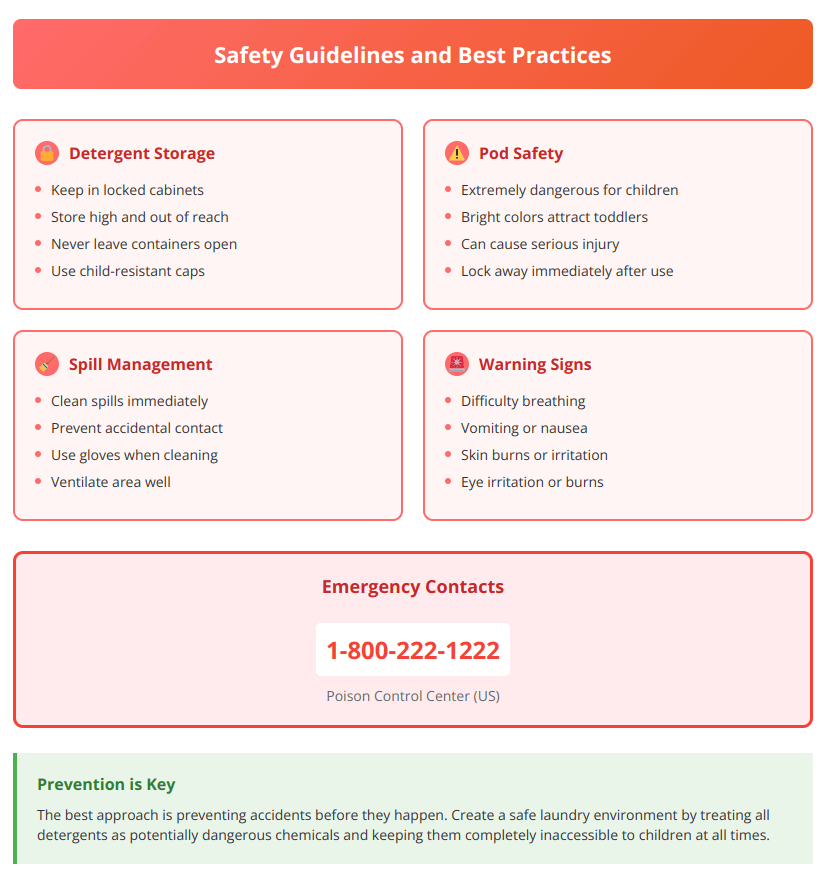
Laundry Room Safety
- Detergent Storage: Keep all laundry products in locked cabinets, especially with curious toddlers around.
- Pod Safety: Laundry pods are particularly dangerous for children due to their bright colors and candy-like appearance. Even small amounts can cause serious breathing problems, stomach issues, or worse.
- Spill Management: Clean up detergent spills immediately to prevent accidental contact or ingestion.
Emergency Preparedness
- Know the Signs: Familiarize yourself with symptoms of detergent poisoning (difficulty breathing, vomiting, skin burns, eye irritation).
- Emergency Contacts: Keep poison control numbers easily accessible (1-800-222-1222 in the US).
- First Aid Knowledge: Understand basic first aid for chemical exposure (rinsing with water, not inducing vomiting).
Cost Considerations and Budget Tips
Cost Comparison by Product Type
| Product Category | Average Cost Per Load | Pros | Cons |
|---|---|---|---|
| Baby Detergent | $0.35-0.50 | Gentlest option | Most expensive |
| Free & Clear Regular | $0.20-0.35 | Good balance | Limited scent options |
| Standard Regular | $0.15-0.25 | Cheapest | May irritate sensitive skin |
| Eco-Friendly | $0.30-0.45 | Environmentally conscious | Higher cost |
Money-Saving Strategies
- Buy in Bulk: Larger sizes often offer better per-load pricing
- Store Brands: Many retailers offer quality gentle detergents at lower prices
- Coupons and Sales: Stock up during promotions on preferred brands
- Concentrate Formulas: Usually more economical than standard strength
Future Considerations

Preparing for School Age
As children enter school, laundry needs evolve:
- Increased soil levels: More outdoor play and activities
- Uniform requirements: Special care for school clothing
- Independence development: Teaching children about clothing care
Teenage Transition
Adolescents may develop new sensitivities due to:
- Hormonal changes: Can affect skin sensitivity
- Activity levels: Increased sweating and soil
- Personal preferences: Desire for specific scents or products
Environmental Impact

Sustainability Considerations
- Packaging: Choose concentrated formulas to reduce plastic waste
- Ingredients: Plant-based options typically have lower environmental impact
- Water Usage: Efficient washing practices conserve resources
- Energy Consumption: Cold water washing reduces energy use
Teaching Environmental Responsibility
Use laundry routines as opportunities to teach children about:
- Conservation: Why we don’t waste water or detergent
- Choices: How product selection affects the environment
- Responsibility: Taking care of belongings to make them last longer
Conclusion
The transition from baby detergent to regular detergent is an important milestone in your child’s development, but it doesn’t need to be stressful or complicated. Most children can safely make this switch around 6 months of age, though individual factors like skin sensitivity, allergies, and family history should guide your specific timing.
Key Takeaways for Parents
- Start the transition gradually by testing regular detergent on one or two items before switching completely
- Choose fragrance-free and dye-free options to minimize irritation risk regardless of your child’s age
- Monitor your child’s skin closely during any product changes and be prepared to revert to gentler options if needed
- Consider your family’s specific needs – children with eczema, allergies, or other sensitivities may need specialized products longer
- Prioritize safety by keeping all laundry products securely stored away from curious toddlers
Long-term Recommendations
- Build relationships with your pediatrician and pediatric dermatologist for guidance on skin-related concerns
- Keep detailed records of which products work well for your child to inform future decisions
- Stay informed about new research in pediatric dermatology and product safety
- Remember that every child is different – what works for friends’ children may not work for yours
The goal isn’t to find the “perfect” detergent but rather to find products that keep your child’s clothes clean while protecting their developing skin. By following evidence-based guidelines, testing products carefully, and staying attuned to your child’s individual needs, you can make informed decisions that support both cleanliness and skin health.
Based on extensive testing by pediatric dermatologists and consumer safety laboratories, here are the top-performing detergents that balance effectiveness with safety for toddlers and children with sensitive skin:
Top-Rated Detergent Recommendations
Expert-tested products with proven safety and effectiveness for toddlers
All Free Clear Liquid Laundry Detergent
Tide Free & Gentle Liquid Detergent
Seventh Generation Free & Clear
Babyganics Baby Laundry Detergent
Testing Methodology: Products were evaluated by independent pediatric dermatologists and consumer testing labs for stain removal effectiveness, skin safety, residue levels, and overall value. Ratings based on standardized testing protocols and real-world parent feedback.
Affiliate Disclosure: We may earn a commission from Amazon purchases made through these links at no additional cost to you. This helps support our research and content creation.
These recommendations are based on rigorous testing for stain removal effectiveness, skin safety profiles, residue levels, and real-world parent feedback. Remember that individual reactions can vary, so always test new products on a small scale before making complete transitions.
When selecting any detergent, prioritize products with third-party certifications and read ingredient lists carefully. The investment in quality, gentle detergents during your child’s early years helps establish healthy skin care practices that benefit the whole family.
Most importantly, remember that this transition is just one small part of your child’s development. While it’s important to make safe choices, don’t let concerns about detergent selection create unnecessary stress. With proper knowledge and careful observation, most families can successfully navigate this transition and establish healthy laundry routines that work for everyone.
Whether you choose to continue with baby-specific products throughout toddlerhood or transition to gentle regular detergents, the most important factors are your child’s comfort, skin health, and your family’s practical needs. Trust your instincts, consult healthcare providers when needed, and remember that you can always adjust your approach as your child grows and their needs change.



